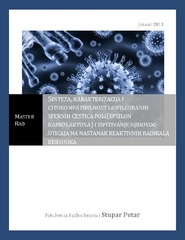Приказ основних података о документу
Sinteza, karakterizacija i citokompatibilnost liofiliziranih sfernih čestica poli(ɛ-kaprolaktona) i ispitivanje njihovog uticaja na nastanak reaktivnih radikala kiseonika
Synthesis, characterization and cytocompatibility of lyophilized spherical particles of poly (ɛ-caprolactone) and examination of their impact on the formation of reactive oxygen species
| dc.contributor | Stevanović, Magdalena | |
| dc.contributor | Ćirić Marjanović, Gordana | |
| dc.contributor | Cvjetićanin, Nikola | |
| dc.contributor | Mojović, Miloš | |
| dc.creator | Stupar, Petar | |
| dc.date.accessioned | 2017-06-10T15:45:07Z | |
| dc.date.issued | 2013 | |
| dc.identifier.uri | https://dais.sanu.ac.rs/123456789/757 | |
| dc.description.abstract | Poli(ε-kaprolakton) (PCL) je biokompatibilan i biodegradabilan poliestar, koji se koristi za različite biomedicinske primene, kao što je kontrolisana dostava lekova, tkivno inženjerstvo, fiksacija koštanih fraktura i druge. Jedan od osnovnih uslova za primenu PCL polimera na polju kontrolisane dostave medikamenata, jesu odgovarajuće morfološke osobine čestica, tj. njihova sferičnost i velika uniformnost. Liofilizacija se koristi u farmaceutskoj industriji prilikom dobijanja najrazličitijih medikamenata, a predstavlja postupak sušenja pri redukovanom pritisku i pri vrlo niskim temperaturama. Iako omogućuje dobijanje čestica dovoljne stabilnosti za distribuciju i skladištenje, ovaj proces generiše izvesne negativne uticaje na strukturu samih formulacija. U cilju prevazilaženja ovakvih nezgoda, formulaciji se dodaju krioprotektanti, supstance koje štite čestice tokom zamrzavanja. Odabir krioprotektanta ni malo nije lak zadatak. Radi obezbeđivanja maksimalne protekcije čestica, potrebno je odabrati pravi tip krioprotektanta i optimizovati njegovu koncentraciju. U radu je opisana sinteza mikrosfera PCL-a fizičkohemijskom rastvarač/nerastvarač metodom i data je komparacija morfoloških karakteristika čestica sušenih u liofilizatoru, uz korišćenje različitih krioprotektanata: poli(L-glutaminske kiseline) (PGA), poli(vinil alkohola) (PVA), saharoze ili glukoze. Uzorci su karakterisani metodama infracrvene spektroskopije sa Fourierovom transformacijom (FT-IR), skenirajuće elektronske mikroskopije (SEM) kao i metodom analize difrakcije laserske svetlosti na česticama (DLS). U analizi svojstava materijala koji je procesiran u cilju potencijalne primene u oblasti biomedicine, veoma je važno ispitati njegovu citokompatibilnost, odnosno meru u kojoj je materijal podesan da koegzistira u prisustvu ćelija, tako da ne utiče na njihov prirodni životni proces, u smislu podsticanja procesa degeneracije i umiranja. Takođe, veoma je važno ispitati i uticaj materijala na prekomerno obrazovanje reaktivnih kiseoničnih vrsta (reactive oxygen species - ROS) i nastanak oksidativnog stresa, koji se dovodi u vezu sa mnogim oboljenjima. Citokompatibilnost uzoraka je ispitana MTT (3-(4,5-dimetiltiazol-2-il)-2,5-difeniltetrazolijum bromid) testom, dok je ROS efekat ispitan DCFH-DA (2′-7′-dihlorodihidrofluorescein diacetat) testom. | sr |
| dc.description.abstract | Poly(ε-caprolactone) (PCL) is a biocompatible and biodegradable polyester, extensively investigated for applications in controlled drug delivery, tissue engineering, bone fracture fixation etc. One of the crucial conditions for the application of polymers in controlled drug delivery are morphological characteristics of the particles, their sphericity and a high uniformity. Freeze drying, also termed lyophilization, is a process of drying in conditions of reduced pressure and very low temperatures. Although this technique was considered as a good method to conserve the integrity of particulate systems, various stresses are generated during the process. To protect nanoparticles from stresses and subsequent aggregation, a cryoprotectant or lyoprotectant is generally used. The selection of a proper cryoprotectant is not straightforward. In some cases, increasing cryoprotectant concentration to a certain level may eventually reach a limit of stabilization or even destabilize nanoparticles. In general, the type of cryoprotectant must be selected and its concentration must be optimized to ensure a maximum stabilization of nanoparticles. The aim of this study was to produce PCL spherical particles using physico-chemical solvent/nonsolvent method, and to evaluate different cryoprotective excipients that were used in order to increase stability of the particles and protect them from freezing stress. Sugars, such as glucose and sucrose, and polymers (PVA and PGA), were added to the formulation to test the effects on the outcome of freeze-dried poly(ε-caprolactone) micro- and nanospheres. Samples were characterized using Fourier Transform Infrared Spectroscopy (FT-IR), Scanning Electron Microscopy (SEM) and Dynamic Light Scattering method (DLS). In the analysis of properties of materials processed for applications in biomedicine, it is of crucial importance to test its cytocompatibility, the extent at which the material is able to coexist in the presence of cells without interrupting their living process in terms of promoting degeneration and death. Furthermore, it is very important to investigate the effects on excessive production of reactive oxygen species (ROS) and the oxidative stress, which is responsible for many diseases. In vitro studies used, include MTT assay (3-(4,5-Dimethylthiazol-2-yl)-2,5-diphenyltetrazolium bromide), testing cytotoxicity as the quality of being toxic to cells, and DCFH-DA assay (2’,7’-dichlordihydrofluorescein-diacetate), testing the possible increase in ROS levels. | en |
| dc.format | (2013) - | |
| dc.format | application/pdf | |
| dc.language | sr | |
| dc.publisher | Belgrade : University of Belgrade, Faculty of Physical Chemistry | |
| dc.relation | info:eu-repo/grantAgreement/MESTD/Integrated and Interdisciplinary Research (IIR or III)/45004/RS// | |
| dc.rights | openAccess | |
| dc.rights.uri | https://creativecommons.org/licenses/by-nc-nd/4.0/ | |
| dc.subject | poly(ε-caprolactone) | |
| dc.subject | freeze drying | |
| dc.subject | cytocompatibility | |
| dc.subject | biocompatible materials | |
| dc.subject | reactive oxygen species | |
| dc.title | Sinteza, karakterizacija i citokompatibilnost liofiliziranih sfernih čestica poli(ɛ-kaprolaktona) i ispitivanje njihovog uticaja na nastanak reaktivnih radikala kiseonika | sr |
| dc.title.alternative | Synthesis, characterization and cytocompatibility of lyophilized spherical particles of poly (ɛ-caprolactone) and examination of their impact on the formation of reactive oxygen species | en |
| dc.type | masterThesis | |
| dc.rights.license | BY-NC-ND | |
| dcterms.abstract | Ступар, Петар; Синтеза, карактеризација и цитокомпатибилност лиофилизираних сферних честица поли(ɛ-капролактона) и испитивање њиховог утицаја на настанак реактивних радикала кисеоника; Синтеза, карактеризација и цитокомпатибилност лиофилизираних сферних честица поли(ɛ-капролактона) и испитивање њиховог утицаја на настанак реактивних радикала кисеоника; | |
| dc.type.version | publishedVersion | |
| dc.identifier.fulltext | https://dais.sanu.ac.rs/bitstream/id/21718/754.pdf | |
| dc.identifier.rcub | https://hdl.handle.net/21.15107/rcub_dais_757 |

